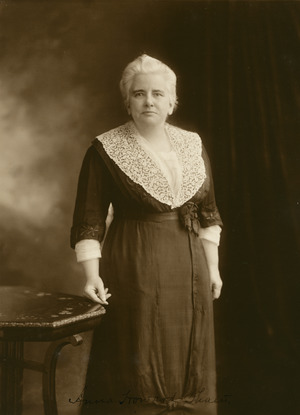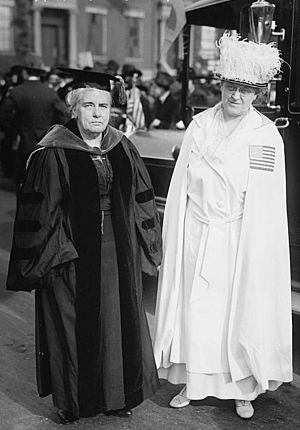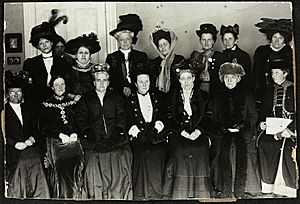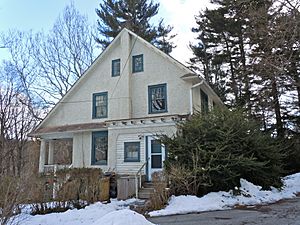Anna Howard Shaw facts for kids
Quick facts for kids
Anna Howard Shaw
|
|
|---|---|
 |
|
| Born | February 14, 1847 |
| Died | July 2, 1919 (aged 72) Moylan, Pennsylvania, United States
|
| Alma mater | Albion College, 1875 Boston University School of Theology, 1880 Boston University School of Medicine, 1886 |
| Occupation |
|
| Signature | |
Anna Howard Shaw (February 14, 1847 – July 2, 1919) was an important American leader. She fought for women's right to vote. She was also a doctor and one of the first women to become a Methodist minister in the United States.
Contents
Anna's Early Life

Anna Howard Shaw was born in Newcastle-upon-Tyne, England, in 1847. When she was four, her family moved to the United States. They first settled in Lawrence, Massachusetts.
When Anna was twelve, her father moved the family to a wild area in northern Michigan. He left Anna's mother and five young children to live there alone. Her mother had hoped for a nice farm, but they found a simple log cabin in the wilderness. It was 40 miles from the nearest town.
Life was very hard on the frontier. Anna helped her family a lot. She helped fix up their home and supported her mother. Anna did many tough jobs like digging a well, chopping wood, and cutting down trees.
Anna felt her father had not thought about how hard life would be for them. While her mother struggled with chores, her father spent time on the Abolition cause. This cause worked to end slavery.
Their family faced more problems. During the Civil War, Anna's sister died while giving birth. Her brother Tom was wounded. When Anna was fifteen, she became a school teacher. Her older brothers and father joined the war. Anna used her earnings to help her family. But it was still hard to make enough money.
Anna's Call to Preach
Anna felt a strong desire to preach from a young age. As a child, she would pretend to preach to the trees in the woods. She was determined to go to college. She wanted to follow what she felt was God's plan for her life. Her family did not approve, but Anna's goal to attend college grew stronger.
After the Civil War, she stopped teaching. She moved in with her married sister Mary in Big Rapids, Michigan. Anna would have preferred physical work like digging. But she had to become a seamstress. This was a common job for women then.
A big moment for Anna was meeting Reverend Marianna Thompson. She was a Universalist minister who came to preach in Grand Rapids. Anna was excited to see a woman preaching. After the service, Anna told Thompson she wanted to be a minister too. Thompson strongly encouraged her to get an education right away.
With Thompson's help, Anna went to Big Rapids High School. Her teacher, Lucy Foot, saw Anna's talent. When Anna was twenty-four, Dr. H. C. Peck asked her to give her first sermon. He wanted to ordain a woman in the Methodist Episcopal Church. Anna was nervous because she had only preached to trees before. But with encouragement from Lucy Foot, Dr. Peck, and her friend Clara Osborn, Anna agreed. She gave her first sermon in Ashton, Michigan.
Her first sermon was a success. But her classmates, friends, and family did not approve of her preaching. They offered to pay for her college if she stopped. Despite this, Anna chose to keep preaching. She was inspired by Mary A. Livermore, a famous speaker. Livermore told her, "if you want to preach, go on and preach…No matter what people say, don’t let them stop you!"
In 1873, the Methodist Church gave Anna a license to preach.
College Challenges
In 1873, Anna entered Albion College, a Methodist school in Albion, Michigan. Her family did not support her career choice. They refused to help her financially. Anna had been a licensed preacher for three years. She earned money by giving talks on temperance. This movement worked to reduce alcohol use.
After Albion College, Anna went to Boston University School of Theology in 1876. She was the only woman in her class of 42 men. She often felt unwelcome there. It was also hard for her to pay for school. Male preachers got free dorm rooms and cheaper food. Anna had to pay more for a room outside. She also struggled to find work. In Boston, there were many preachers, so it was harder to find jobs. She often felt cold, hungry, and lonely. Anna even wondered if being a minister was right for her.
Despite these difficulties, Anna kept going. In 1880, she and Annie Oliver were not allowed to be ordained by the Methodist Episcopal Church. This was even though Anna had the best exam score that year. But she was ordained in the Methodist Protestant Church.
After becoming a minister, Anna earned a medical degree (MD) from Boston University in 1886. While in medical school, she became a strong supporter of political rights for women.
Leading the Women's Suffrage Movement

Working with Susan B. Anthony
Starting in 1886, Anna Shaw led the Franchise Department of the Women's Christian Temperance Union (WCTU). Her job was to work for women's right to vote. She believed voting would help with "home protection" and temperance laws. But she soon focused more on the suffrage movement. She gave lectures for the Massachusetts Suffrage Association. Later, she lectured for the American Woman Suffrage Association (AWSA).
Anna first met Susan B. Anthony in 1887. In 1888, Shaw attended the first meeting of the International Council of Women. Susan B. Anthony encouraged her to join the National Woman Suffrage Association (NWSA). Anna agreed. She helped the two main suffrage groups merge. This created the National American Woman Suffrage Association (NAWSA). This brought unity to the movement after many years. From 1904 for the next eleven years, Anna Shaw was the president of NAWSA. Under her leadership, NAWSA continued to push for a national law giving women the right to vote.
Stepping Down from NAWSA Leadership
In the early 1900s, Alice Paul and Lucy Burns were NAWSA members. They started using more direct methods to fight for women's suffrage. For example, they picketed the White House during World War I. They were inspired by the success of suffragettes in England. As president of NAWSA, Anna was pressured to support these tactics.
However, Anna believed that "nothing of permanent value has ever been secured by it that could not have been more easily obtained by peaceful methods." She stayed true to Susan B. Anthony's idea of not using militant tactics. In 1915, she resigned as NAWSA president. Her friend Carrie Chapman Catt took her place.
Later Years and Passing
During World War I, Anna Shaw led the Women's Committee of the United States Council of National Defense. For her work, she became the first woman to receive the Distinguished Service Medal. She continued to lecture for women's right to vote for the rest of her life.
Just months before she passed away, Anna spoke at Baylor University in Waco, Texas. She said that the only way to argue that America was a democracy but women couldn't vote was "to prove that women are not people." She urged the women there to join the suffrage movement.
She also spoke at the 1919 National Conference on Lynching. She presented women's right to vote as a step against lynching.
Anna Shaw passed away from pneumonia at her home in Moylan, Pennsylvania. She was seventy-two years old. This was only a few months before Congress approved the Nineteenth Amendment to the US Constitution. This amendment finally gave women the right to vote across the country.
Anna's Personal Life
Anna built a home at 240 Ridley Creek Rd., Media. She lived there with her companion Lucy Elmina Anthony (1859–1944). Lucy was the niece of Susan B. Anthony. Anna and Lucy were together for thirty years. Lucy was with Anna when she passed away.
Anna's Legacy
Anna Howard Shaw's 1915 speech, "The Fundamental Principle of a Republic," is considered one of the top 100 speeches of the 20th Century.
In 2000, she was honored by being added to the National Women's Hall of Fame. In 2020, she was named an honoree of the National Women's History Alliance.
Several places are named after her:
- The Anna Howard Shaw Women's Center at Albion College.
- The Anna Howard Shaw Center at Boston University School of Theology. This center became the women's center for the Northeastern Jurisdiction of the United Methodist Church.
- The Anna Howard Shaw Junior High School in Southwest Schuylkill, Philadelphia, built in 1922–1924.
- A statue of Anna Howard Shaw was put up next to the Community Library in Big Rapids, Michigan, in 1988.
See also
 In Spanish: Anna Howard Shaw para niños
In Spanish: Anna Howard Shaw para niños



